Pricing in the ERP-system SAP Business One
We continue a series of publications about the solution for small and medium-sized businesses from the company SAP - SAP Business One. In this article, we consider the standard pricing options in SAP Business One and the option of implementing non-standard pricing applied by our partner, CMD-software, on the implementation project.
The price of a product or service is a military weapon in the competitive struggle for the buyer. In ordinary life, sellers influence our purchasing decision with a wide range of tools: personal offers, loyalty programs, bonuses, gifts, discounts, etc. These shares are the result of the pricing policy of the company, aimed at the buyer.
The selling enterprise builds a pricing matrix taking into account many factors, including the data subject to internal accounting: product range, quantity of goods in stock, delivery terms, customer category, etc.
The pricing policy of an enterprise imposes requirements on the ERP system for identical reflection of various pricing approaches in conjunction with many credentials. For the success of the sales process, an adequate display of the pricing logic of the trade organization is an important and responsible task of setting up an information system.
Let's consider using examples of how the solution from SAP for small and medium businesses copes with pricing issues. In SAP Business One, with simple settings, you can achieve various price variations and satisfy most customer needs.
')
The figure highlights and illustrates the main approaches to pricing, as well as examples, grouped according to the principle of organizing the standard features of the system:
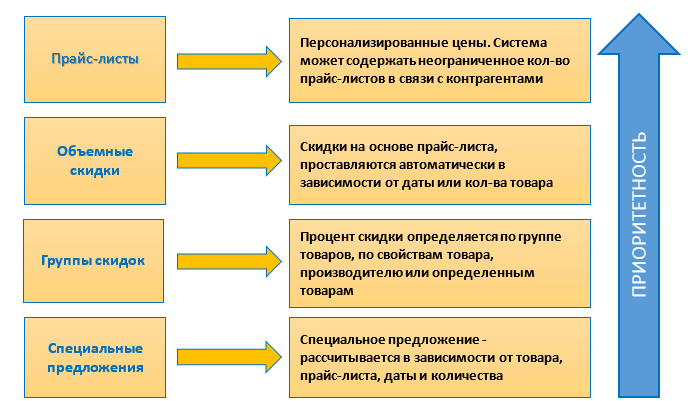
The main types of pricing in SAP Business One
1. Price lists
In SAP Business One it is possible to maintain various versions of price lists for sales and purchases. Price lists sales / purchases are created in Stocks => Price lists => Prices lists:
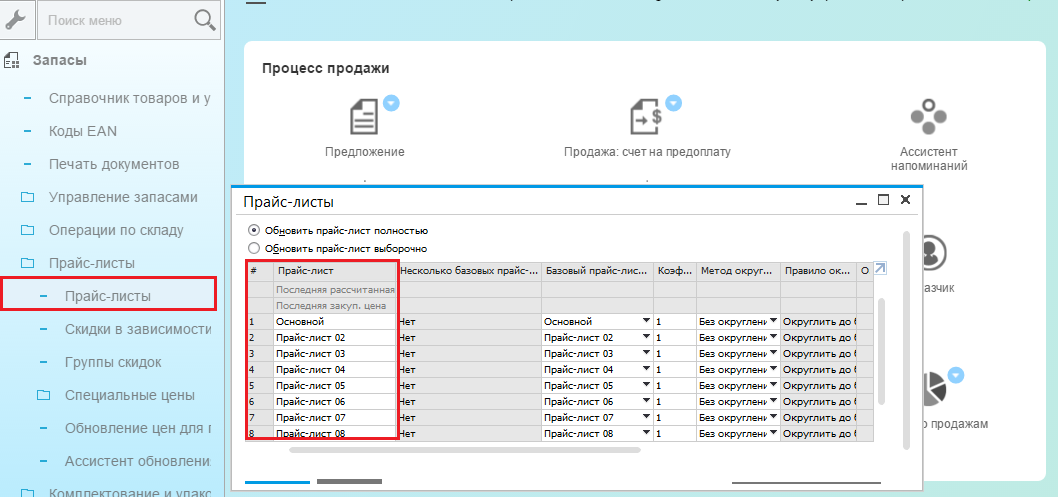
Storage of price lists
Automatic maintenance is applied for two price lists: The last calculated price (updated with the inventory valuation modeling report) and the Last purchase price (updated when the goods are entered into stocks with the original price). The price list can be created on the basis of another price list (for example, Last purchase price) using conversion factors:
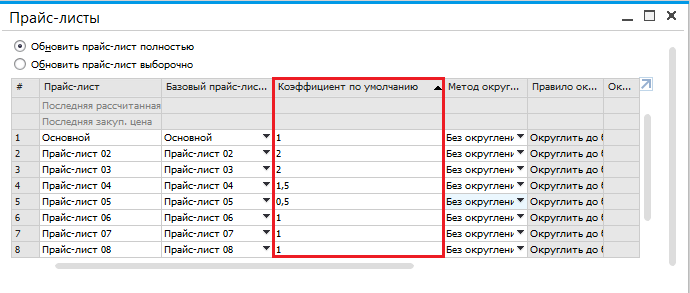
The coefficients for the calculation of price lists
It is possible to maintain price lists with or without VAT, in several currencies (in main and two additional) - for example, RUB, USD, EUR. It is possible to fix the price per unit, when the coefficient changes - the price will not be recalculated:

Setting the price list with / without VAT, fixed price in different currencies
A specific price list can be assigned to a specific customer / supplier. Price list binding is carried out in the client card Business Partners => Directory of business partners => Payment terms tab => Price List field :

Setting the price list for the supplier
To edit the price in the price list for a certain product, it is enough to select the price list in the product card and change the price Inventory => Reference book of goods and services => Price list field :

Setting the price of goods
2. Volume discounts
The use of discounts depending on the period and quantity allows you to determine the discounts by date and on the basis of the quantity of goods on the current price list. The discounts entered here override the base price in the price list assigned to this business partner. Discounts do not apply if there is a special price for a business partner or group of discounts for a customer or product:
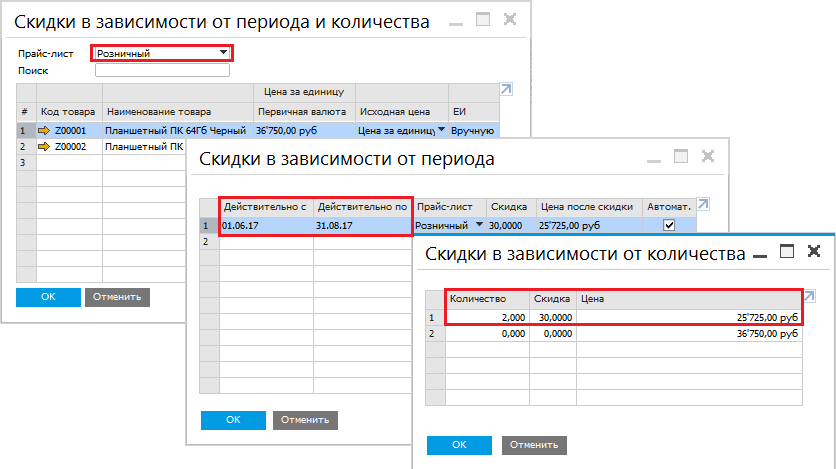
Discounts depending on the period and quantity
3. Discount groups
Discount groups are configured in Stocks => Price Lists => Discount Groups .
Assignment of discount groups is possible for all business partners, a specific customer / supplier, a group of customers or a group of suppliers:

Customization of discounts for a specific customer
Discount groups by product groups are configured on the Product Groups tab. You can activate the validity of this discount:

Setting discounts for products
Discount groups for product properties are configured on the Product Properties tab. To add an additional discount, you must set the value of the discount ratio = Total :
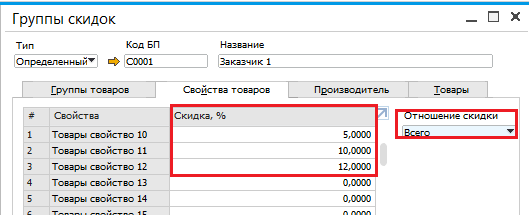
Setting discounts on the properties of goods
Discount groups can be assigned by manufacturers (brands) on the Manufacturer tab:
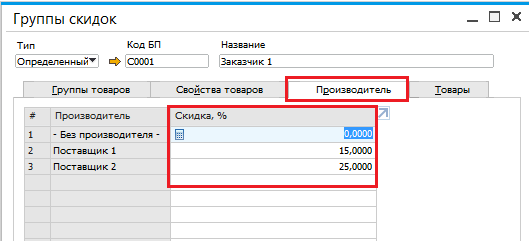
Setting discounts for manufacturers (brands)
To calculate discounts for certain products, select these products on the tab.
Products :
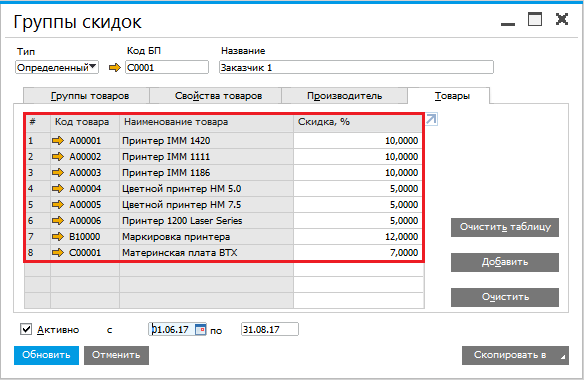
Customization of product discounts
4. Special offers
SAP Business One allows you to set a price for a customer or supplier for individual items in one or several price lists:

Setting special prices for a specific customer
5. Non-standard pricing
On one of the projects, the company CMD-soft received a request from the customer to calculate the discount at the document level, applying this discount to all lines, and not just to the Total field.
The discount value to the invoice is entered in the additional field of the Sales Order document. The discount is calculated in proportion to the value of the position of the account and is added to the discount in each line of the document. When the total discount field is reset, the discount values in the rows are rolled back to their initial values before editing the document.
Additionally, it was necessary to implement a dynamic recalculation of field values. At the level of the Sales Order, if the value in one of the listed fields is changed manually, the related values of the remaining fields in the line are automatically recalculated:
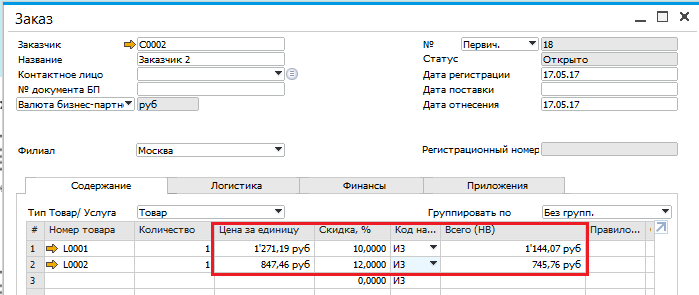
Cascading recalculation of values of related fields when changing values in one of the fields
To implement non-standard pricing scenarios, various tools built into SAP Business One can be used. The flexibility of the solution and the independence of the kernel allows you to add custom objects to system documents without writing code (programming).
Create custom field
Using the Custom Fields tool , you can add a new field and link it to documents, core data and other system objects (both at the header level and at the row level). Custom fields can be of various types: alphanumeric, digital, date or time, units of measurement and calculation. In accordance with the selected field type, the appearance of the data display changes. The values of these fields can be associated with entities (system or user table), include a limited set of data (entered when defining the field), or meet certain criteria. The user field can be assigned a standard value and / or a mandatory input property (the user will not be able to save the document if this field is not filled in).
Add a custom field at the header level of the document in which we will enter the size of the additional discount:
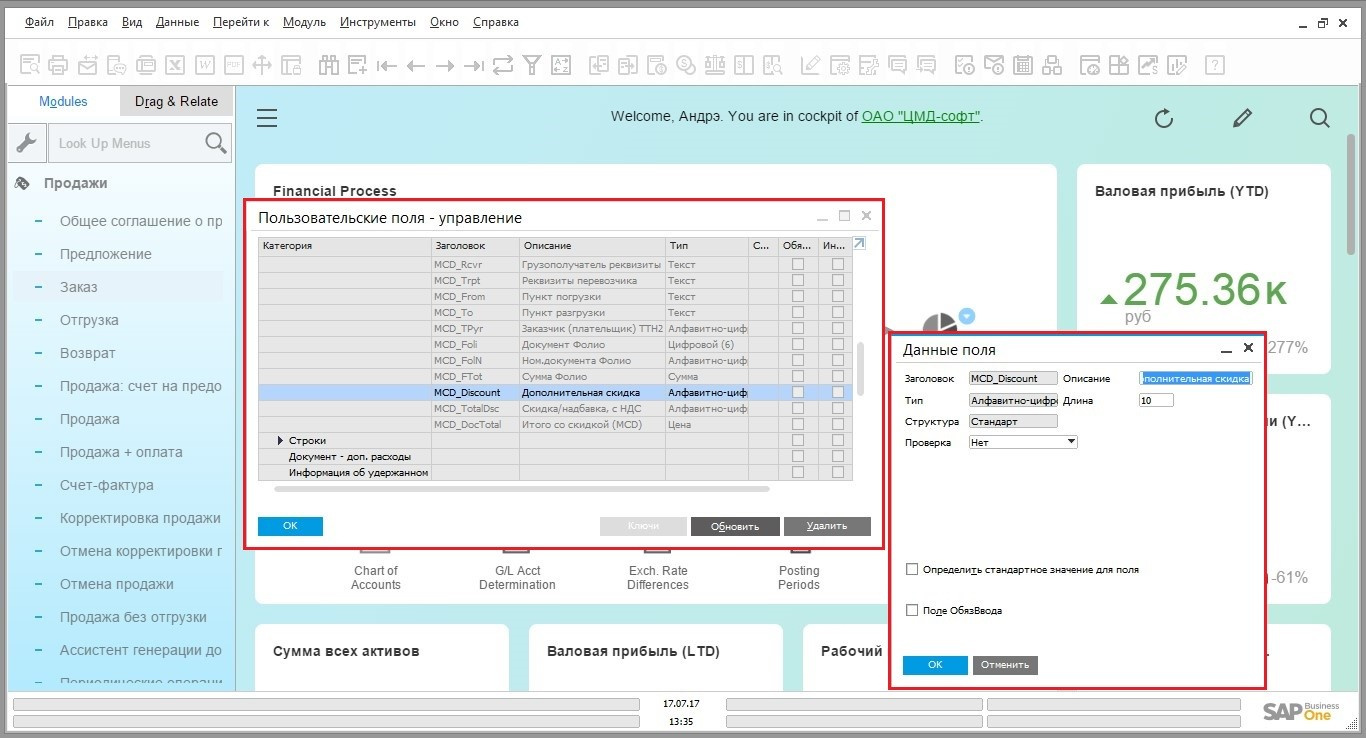
Add custom field at document header level
Create custom query
To form the calculation algorithm, we use the tools in the Requests section. Using these tools, you can build, modify, and manage SQL queries. For the "inexperienced" there is a query assistant - a wizard that helps you step by step to create your SQL query.
In SAP Business One, it is possible to calculate at the level of an open document when the value has not yet been entered into the system or user table (the document is not saved). To do this, use the syntax of the form $ [$ XYZ], where X is the system number or field name, and Y and Z are additional conditions.
In the request to determine the user value (in our case - non-standard pricing), we indicate the dynamic syntax for reading open form elements:
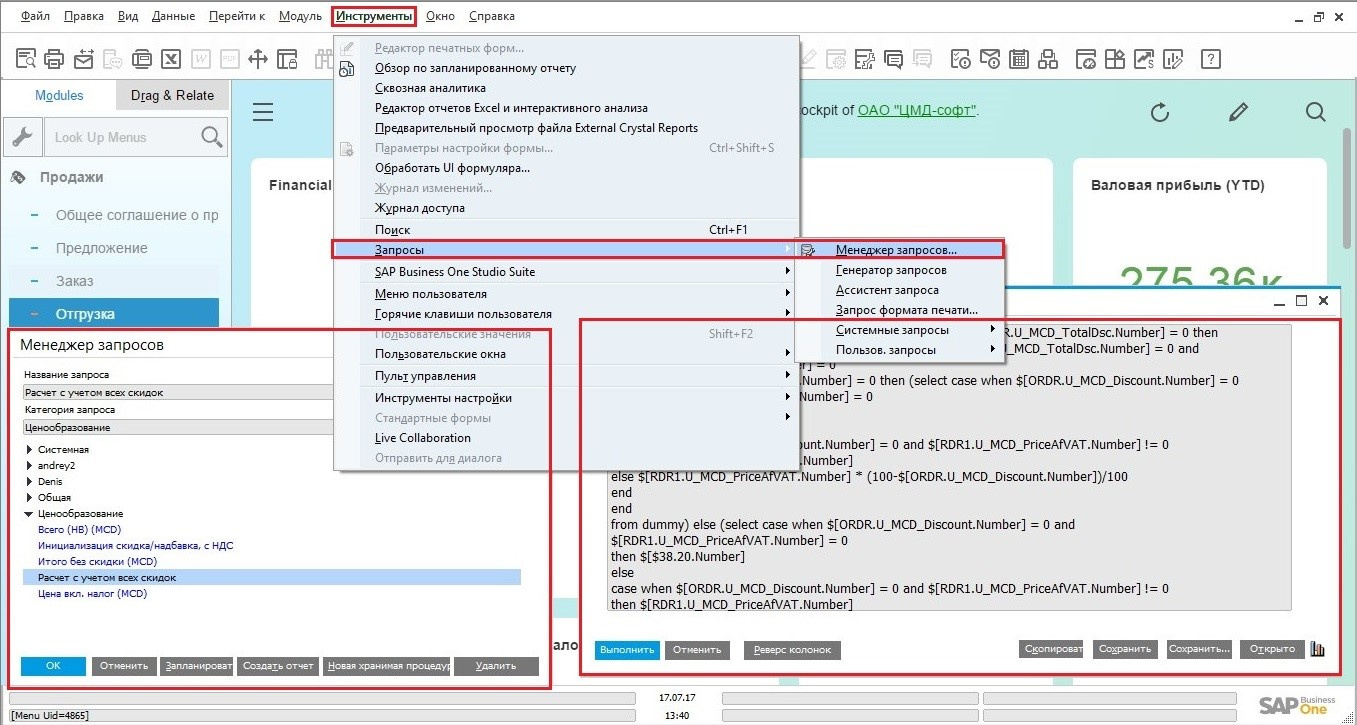
Add custom SQL query
Create custom values
After the custom field has been formed for entering information on an additional discount and a request for calculating a non-standard price, it is necessary to link these two elements in the document.
We activate the display of custom fields at the header level (at the row level they are activated automatically). By default, custom fields are displayed in the window to the right of the form. Users with the appropriate level of authority can activate the form editing mode and drag an element from the side window to the place of interest in the document header. Open the required document Sales order and transfer the custom field Additional discount in the document header.
Put the mouse cursor in the Total field (HB) - the created query will be executed in this field. Add a custom value based on the query.
We select the created request. Set the setting for automatic calculation of the value when the created custom field is changed. Select the option View saved user values . Save the results:
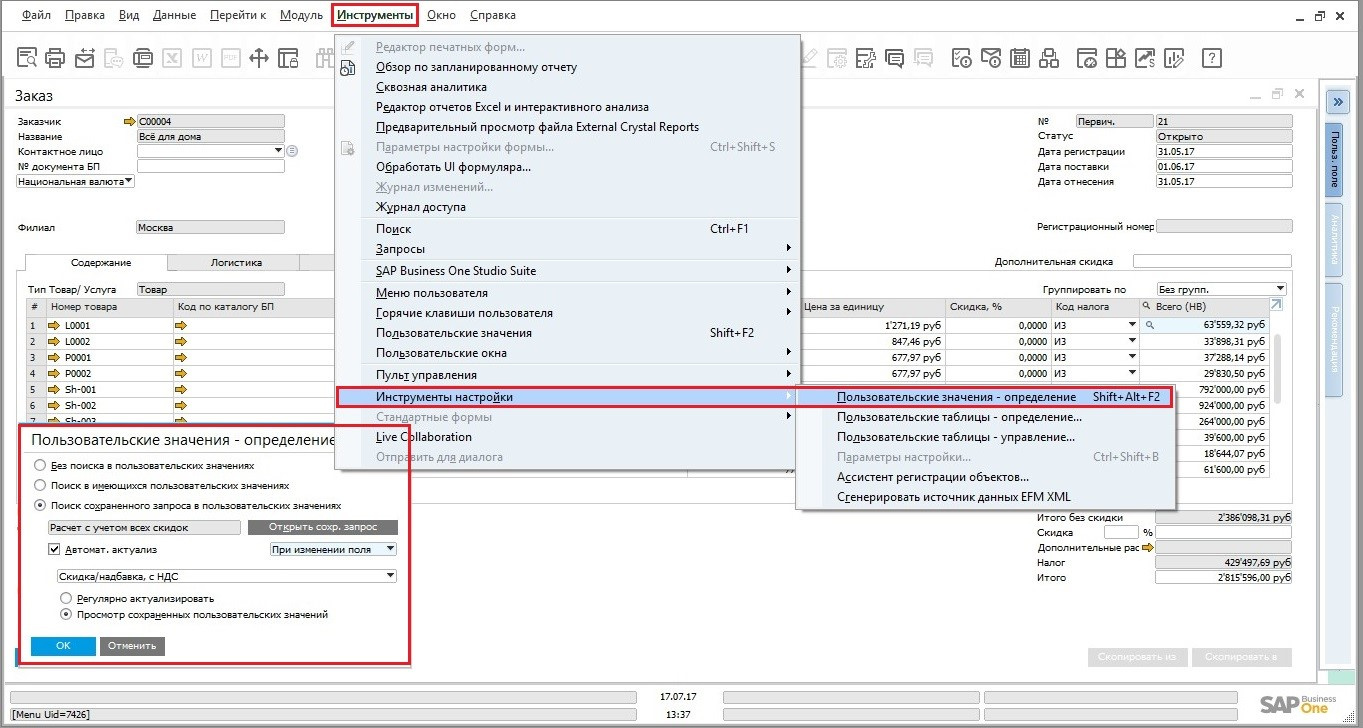
Assigning a custom query to a field
Result
Open the marketing document Sales Order . Find the required document or create a new one. In the Custom field Additional discount, we enter the discount amount, for example, 50. The Discount,%, Total (HB) field and the total cost of the order have been reduced by 50% using the created query and setting the custom value based on the request:
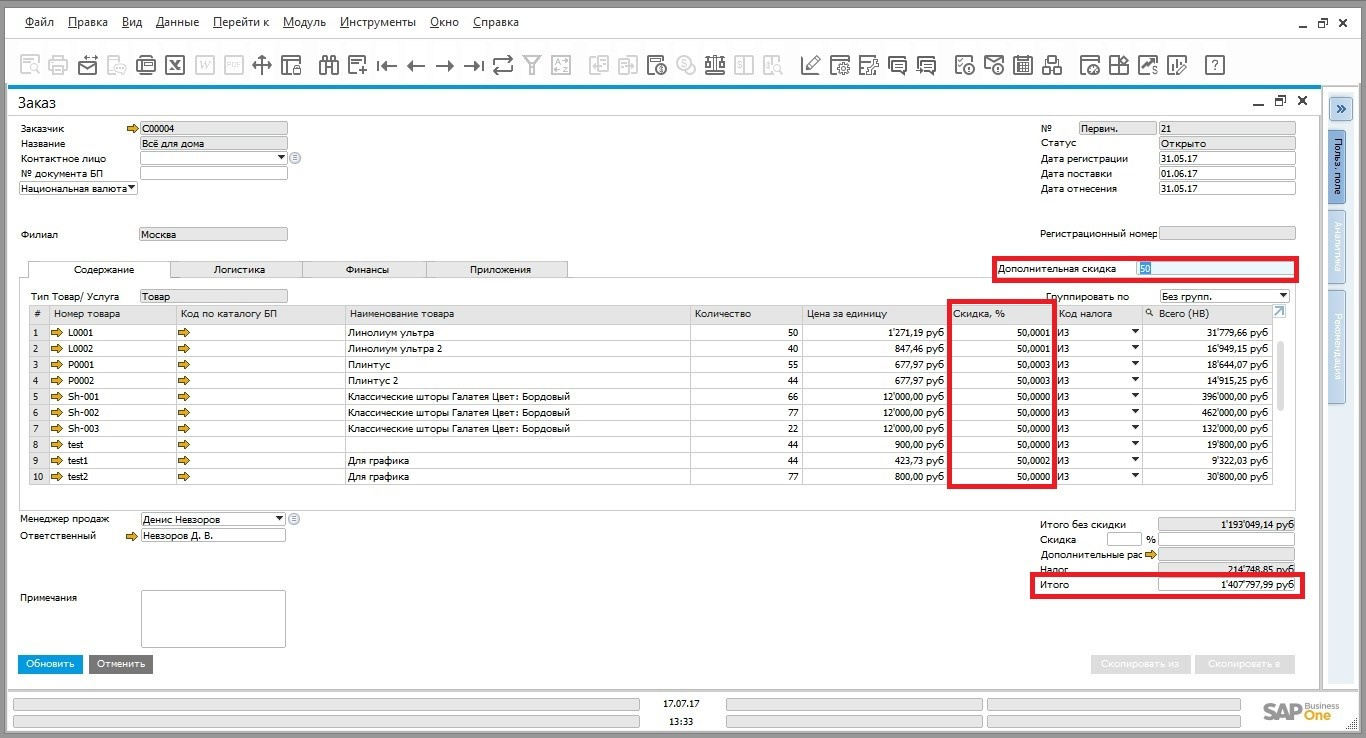
Automatic calculation of values in the associated document fields
As you could see in this article, SAP Business One solution has a variety of functions for implementing various pricing policies of a company, and also has the ability to refine it.
See examples of SAP Business One implementations on our website.
Video with reviews of opportunities and not only available on our YouTube channel
Comment, share your impressions, ask questions.
Thank you all for reading and feedback!
Previous SAP Business One content:
SAP Business One ERP Solution Features on SAP HANA Platform
Business One: ERP for small business exists
The price of a product or service is a military weapon in the competitive struggle for the buyer. In ordinary life, sellers influence our purchasing decision with a wide range of tools: personal offers, loyalty programs, bonuses, gifts, discounts, etc. These shares are the result of the pricing policy of the company, aimed at the buyer.
The selling enterprise builds a pricing matrix taking into account many factors, including the data subject to internal accounting: product range, quantity of goods in stock, delivery terms, customer category, etc.
The pricing policy of an enterprise imposes requirements on the ERP system for identical reflection of various pricing approaches in conjunction with many credentials. For the success of the sales process, an adequate display of the pricing logic of the trade organization is an important and responsible task of setting up an information system.
Let's consider using examples of how the solution from SAP for small and medium businesses copes with pricing issues. In SAP Business One, with simple settings, you can achieve various price variations and satisfy most customer needs.
')
The figure highlights and illustrates the main approaches to pricing, as well as examples, grouped according to the principle of organizing the standard features of the system:

The main types of pricing in SAP Business One
1. Price lists
In SAP Business One it is possible to maintain various versions of price lists for sales and purchases. Price lists sales / purchases are created in Stocks => Price lists => Prices lists:

Storage of price lists
Automatic maintenance is applied for two price lists: The last calculated price (updated with the inventory valuation modeling report) and the Last purchase price (updated when the goods are entered into stocks with the original price). The price list can be created on the basis of another price list (for example, Last purchase price) using conversion factors:

The coefficients for the calculation of price lists
It is possible to maintain price lists with or without VAT, in several currencies (in main and two additional) - for example, RUB, USD, EUR. It is possible to fix the price per unit, when the coefficient changes - the price will not be recalculated:

Setting the price list with / without VAT, fixed price in different currencies
A specific price list can be assigned to a specific customer / supplier. Price list binding is carried out in the client card Business Partners => Directory of business partners => Payment terms tab => Price List field :

Setting the price list for the supplier
To edit the price in the price list for a certain product, it is enough to select the price list in the product card and change the price Inventory => Reference book of goods and services => Price list field :

Setting the price of goods
2. Volume discounts
The use of discounts depending on the period and quantity allows you to determine the discounts by date and on the basis of the quantity of goods on the current price list. The discounts entered here override the base price in the price list assigned to this business partner. Discounts do not apply if there is a special price for a business partner or group of discounts for a customer or product:

Discounts depending on the period and quantity
3. Discount groups
Discount groups are configured in Stocks => Price Lists => Discount Groups .
Assignment of discount groups is possible for all business partners, a specific customer / supplier, a group of customers or a group of suppliers:

Customization of discounts for a specific customer
Discount groups by product groups are configured on the Product Groups tab. You can activate the validity of this discount:

Setting discounts for products
Discount groups for product properties are configured on the Product Properties tab. To add an additional discount, you must set the value of the discount ratio = Total :

Setting discounts on the properties of goods
Discount groups can be assigned by manufacturers (brands) on the Manufacturer tab:

Setting discounts for manufacturers (brands)
To calculate discounts for certain products, select these products on the tab.
Products :

Customization of product discounts
4. Special offers
SAP Business One allows you to set a price for a customer or supplier for individual items in one or several price lists:

Setting special prices for a specific customer
5. Non-standard pricing
On one of the projects, the company CMD-soft received a request from the customer to calculate the discount at the document level, applying this discount to all lines, and not just to the Total field.
The discount value to the invoice is entered in the additional field of the Sales Order document. The discount is calculated in proportion to the value of the position of the account and is added to the discount in each line of the document. When the total discount field is reset, the discount values in the rows are rolled back to their initial values before editing the document.
Additionally, it was necessary to implement a dynamic recalculation of field values. At the level of the Sales Order, if the value in one of the listed fields is changed manually, the related values of the remaining fields in the line are automatically recalculated:
- Price per unit (indicated without VAT, default is taken from the price list)
- Discount% (value can not be more than 100%)
- Price incl. tax (calculated including Discounts plus VAT),
- Total (HB) (default is the result of multiplying the values of the Price on. Tax and Quantity fields)

Cascading recalculation of values of related fields when changing values in one of the fields
To implement non-standard pricing scenarios, various tools built into SAP Business One can be used. The flexibility of the solution and the independence of the kernel allows you to add custom objects to system documents without writing code (programming).
Create custom field
Using the Custom Fields tool , you can add a new field and link it to documents, core data and other system objects (both at the header level and at the row level). Custom fields can be of various types: alphanumeric, digital, date or time, units of measurement and calculation. In accordance with the selected field type, the appearance of the data display changes. The values of these fields can be associated with entities (system or user table), include a limited set of data (entered when defining the field), or meet certain criteria. The user field can be assigned a standard value and / or a mandatory input property (the user will not be able to save the document if this field is not filled in).
Add a custom field at the header level of the document in which we will enter the size of the additional discount:

Add custom field at document header level
Create custom query
To form the calculation algorithm, we use the tools in the Requests section. Using these tools, you can build, modify, and manage SQL queries. For the "inexperienced" there is a query assistant - a wizard that helps you step by step to create your SQL query.
In SAP Business One, it is possible to calculate at the level of an open document when the value has not yet been entered into the system or user table (the document is not saved). To do this, use the syntax of the form $ [$ XYZ], where X is the system number or field name, and Y and Z are additional conditions.
In the request to determine the user value (in our case - non-standard pricing), we indicate the dynamic syntax for reading open form elements:

Add custom SQL query
Create custom values
After the custom field has been formed for entering information on an additional discount and a request for calculating a non-standard price, it is necessary to link these two elements in the document.
We activate the display of custom fields at the header level (at the row level they are activated automatically). By default, custom fields are displayed in the window to the right of the form. Users with the appropriate level of authority can activate the form editing mode and drag an element from the side window to the place of interest in the document header. Open the required document Sales order and transfer the custom field Additional discount in the document header.
Put the mouse cursor in the Total field (HB) - the created query will be executed in this field. Add a custom value based on the query.
We select the created request. Set the setting for automatic calculation of the value when the created custom field is changed. Select the option View saved user values . Save the results:

Assigning a custom query to a field
Result
Open the marketing document Sales Order . Find the required document or create a new one. In the Custom field Additional discount, we enter the discount amount, for example, 50. The Discount,%, Total (HB) field and the total cost of the order have been reduced by 50% using the created query and setting the custom value based on the request:

Automatic calculation of values in the associated document fields
As you could see in this article, SAP Business One solution has a variety of functions for implementing various pricing policies of a company, and also has the ability to refine it.
See examples of SAP Business One implementations on our website.
Video with reviews of opportunities and not only available on our YouTube channel
Comment, share your impressions, ask questions.
Thank you all for reading and feedback!
Previous SAP Business One content:
SAP Business One ERP Solution Features on SAP HANA Platform
Business One: ERP for small business exists
Source: https://habr.com/ru/post/334114/
All Articles